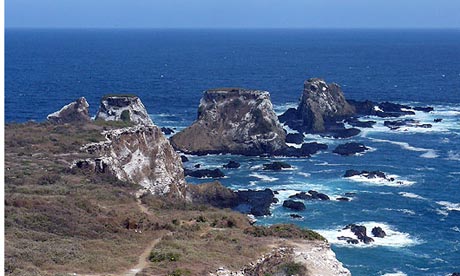
A 40-tonne, barnacle-speckled humpback whale glided underneath our small craft like an enormous shadow. I clung on to a slippery rail while the boat bucked and hopped on the steel-blue Pacific waves. "Don't worry," said our captain, "they just like to scratch their backs against the hull."
From June to September, whale sightings – if not always as close as ours – are virtually guaranteed off the coast of Ecuador's Manabí province. I'd set sail just half an hour earlier from the dusty port town of Puerto López, the base for trips around Machalilla national park, the country's largest protected coastal area.
It was another bumpy hour to Isla de la Plata, or Silver Island. Some say the uninhabited island derives its name from the centuries-old buried treasure of Sir Francis Drake. Others that "silver" refers to the large deposits of guano that stain its dark cliffs. It's also been christened the poor-person's Galapagos by the likes of Lonely Planet and Frommer's for its abundance of marine birdlife. After negotiating the steep path to the island's central plateau, I could understand why. Seemingly fearless blue-footed boobies padded inquisitively alongside us in their striking footwear. We crept past pairs of nesting waved albatrosses, while frigate birds perched in the trees like strange fruit, the males' vivid red throats inflated to attract a mate.
Hugo from the Netherlands – on his first trip to Ecuador since he was a naturalist guide in the Galapagos almost 30 years before – was entranced. As we watched a blue-footed booby trying to placate its hungry chick, I asked him how it measured up. "If you'd brought me here blindfolded I would say we were definitely on the islands. Definitely."
Back in Puerto López, fishermen dragged ashore their nets under siege from frigate birds. Primary-coloured taxi motos plied their trade along the malecón and shrimps were sold from ramshackle wooden stalls. It was tempting to linger over a delicious ceviche, washed down with beer but I, too, was making a return journey – to the pioneering eco lodge, Alandaluz, a 15-minute drive along the coast.
It was 15 years since I'd first first visited Alandaluz. Then it was a backpackers' word-of-mouth find, built from bamboo and palm thatch – the kind of place you went for a couple of days and stayed for a couple of weeks. I slept alfresco in a hammock, lulled by the roar of the ocean. But in 1997, a malevolent El Niño flattened the lodge. Everything had to be rebuilt, this time using a sturdier combination of local stone and plaster as well as bamboo. Now there's a swimming pool, a small shop selling local crafts and the chance to ride bikes and horses and go diving and kayaking.
What hasn't changed is the tranquil setting, the huge shell-strewn beach, and the commitment to sustainability – from a full recycling programme, to bio-architecture and an organic garden. The menu is more sophisticated today – I enjoyed viudo, a medley of fish, shrimps and squid, smothered in a rich sauce of peanuts, coconut and spices – but it's still home-grown or locally sourced. Vitally, the expanding project – including the nearby Cantalapiedra wildlife refuge, an area of pristine rainforest up the Ayampe river – has created dozens of jobs for the surrounding communities.
I'd barely left the beach on my last visit; now I had the opportunity to venture inland into Machalilla national park, which protects what remains of the country's endangered dry tropical forest, and where the vegetation includes fluffy kapok trees and fragrant palo santo (or holy wood) trees.
Within the park sits the indigenous village and archaeological site of Agua Blanca, and a small museum. When the Incas ruled the Ecuadorian highlands, this area was occupied by the Mantena tribe, and was the centre of a trading network that stretched north to Mexico, using spondylus shells, which were worth more than gold, as currency. Now 16 families remain, living off fishing, agriculture and crafts.
The park is home to over 200 species of bird as well as deer, armadillos and two species of monkey. With at least a day to spare you can also explore the Chongón-Colonche mountains, a little further inland, where dry forest morphs into cloud forest, with help from the garua, or sea mist.
I settled for a three-hour walk through the forest with a local guide and Mantena descendent, who showed me ancient burial urns, the atmospheric remains of a temple and a natural volcanic lagoon.
Later, I hiked along the park's coastal path to the glorious sweep of Los Frailes beach, bathed in the golden glow of late afternoon. Save for hordes of scurrying Sally Lightfoot crabs, it was just me, the surf and the sunset. I took a long swim in the pellucid water and felt like the Pacific was mine alone.

